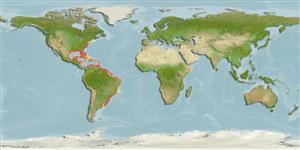Classificação / Names
Common names from other countries
Referência principal
Tamanho / Peso / Idade
Max length : 30.0 cm TL macho/indeterminado; (Ref. 26340); common length : 18.0 cm TL macho/indeterminado; (Ref. 5217)
Length at first maturity
Lm 12.0 range ? - ? cm
Ambiente
; marinhas; estuarina bentopelágico; intervalo de profundidade 15 - 136 m (Ref. 36453)
Clima / Intervalo
Subtropical, preferred 27°C (Ref. 107945); - 38°S
Distribuição
Descrição breve
Espinhos dorsais (total): 2 - 5; Raios dorsais moles (total): 38-47; Espinhos anais 2-3; Raios anais moles: 35 - 45. This species is distinguished by the following characters: body very deep (its depth 1.6 to 1.8 in total length), bounded by even curves and strongly compressed; snout short and blunt, about equal to eye diameter; mouth small, tip of maxillary just reaching to below eye margin; teeth in jaws weak, in 1 row, those in the upper jaw slightly recurved, simple and pointed; dorsal and anal fin bases very long (about equal in length), both fins falcate, the length of their longest rays greater than head and preceded by 3 weak spines; caudal fin stiff and deeply forked, both its lobes longer than head; pectoral fins narrow and much longer than head; pelvic fins absent; no conspicuous series of pores below dorsal fin; lateral line high, following dorsal profile; scales small and easily detached, extending to cheeks and bases of vertical fins; body color pale blue to green above, silvery with a golden/yellow tinge below (Ref. 53006).
Categoria na Lista Vermelha da IUCN (Ref. 115185)
Ameaça para o homem
Harmless
Utilização humana
Pescarias: pouco comercial
Mais informação
ReferênciasAquaculturaPerfil para aquaculturaEstirpesGenéticaFrequência dos alelosHereditariedadeDoençasProcessamentoMass conversion
ColaboradoresFotografiasStamps, CoinsSonsCiguateraVelocidadeTipo de nataçãoÁrea branquialOutras referênciasCérebrosVisão
Ferramentas
Relatórios especiais
Descarregue XML
Fontes da internet
Estimates of some properties based on models
Phylogenetic diversity index
PD50 = 0.5078 many relatives (e.g. carps) 0.5 - 2.0 few relatives (e.g. lungfishes)
Nível Trófico
4.5 ±0.0 se; Based on diet studies.
Resiliência
Elevada, tempo mínimo de duplicação da população menor que 15 meses (Preliminary K or Fecundity.)
Vulnerabilidade
Low vulnerability (17 of 100)
Categoria de preço
